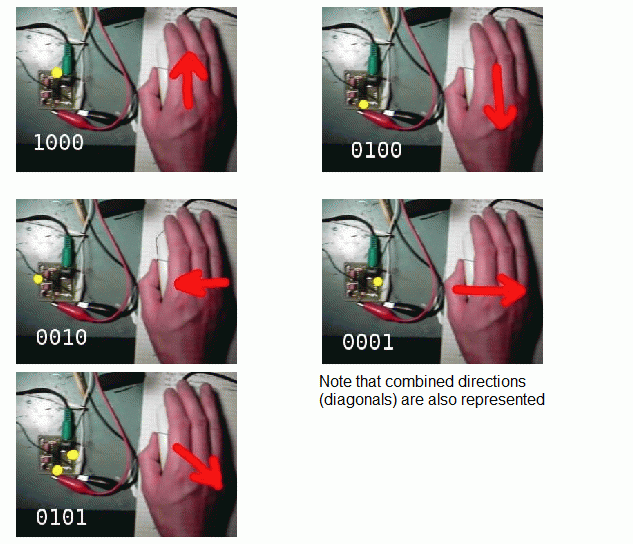Optical Mouse for Robot Odometry
I thought this was pretty tricky, using an optical mouse under a robot to sense motion and direction of motion.
http://imakeprojects.com/Projects/seeing-eye-mouse Looks like this guy used it just for gross motion detection on a Sumo robot, but I wonder if it might be possible to use it for dead reckoning and odometry to help a small robot get from A to B. And possibly C. Then back to A...
It all hinges on the surface readability, sampling speed, and robot speed. It would only work on a smooth uniform surface that would give consistent optical results (like a Sumo ring, mazes,·tabletop, etc). But it eliminates wheel slip, which throws off wheel encoders. Food for thought.

▔▔▔▔▔▔▔▔▔▔▔▔▔▔▔▔▔▔▔▔▔▔▔▔
·"If you build it, they will come."
http://imakeprojects.com/Projects/seeing-eye-mouse Looks like this guy used it just for gross motion detection on a Sumo robot, but I wonder if it might be possible to use it for dead reckoning and odometry to help a small robot get from A to B. And possibly C. Then back to A...
It all hinges on the surface readability, sampling speed, and robot speed. It would only work on a smooth uniform surface that would give consistent optical results (like a Sumo ring, mazes,·tabletop, etc). But it eliminates wheel slip, which throws off wheel encoders. Food for thought.
▔▔▔▔▔▔▔▔▔▔▔▔▔▔▔▔▔▔▔▔▔▔▔▔
·"If you build it, they will come."




Comments
I've done some experimenting with optical mouse chips. They have a very small aperture, designed for a very short focal length lens. This could make them difficult to implement in a design requiring more distance from the surface being monitored. As I see it, these are the two options: 1) Widen the aperture to accommodate a different lens, or 2) use corrective optics to increase the effective focal length. Number one is a problem because it apparently exposes the raw silicon to the elements. I haven't explored the possibilities yet of number two, but it seems to be the most promising.
In any event, I doubt that a mouse chip would be effective at odometry, since it is unable to detect rotations (i.e. turns). Two of them in tandem might offset this deficiency, however. Another factor is that the apparent distance traveled will depend on the sensor's distance to the sensed surface, which could vary over rough terrain. A telecentric lens can correct this, but it adds yet another level of complexity.
-Phil
In the case of this one project, they wrote some drivers for their micro to just read the mice right out of their USB cables (their mobo was Linux, I think, which is one reason I wanted to track the project down). In any case, the result was they had to do very very little physical modification of the mice. So one mouse per wheel and yer good to go. This was an approach I've really wanted to play with, but I've been waiting for the right project.
▔▔▔▔▔▔▔▔▔▔▔▔▔▔▔▔▔▔▔▔▔▔▔▔
When the going gets weird, the weird turn pro. -- HST
1uffakind.com/robots/povBitMapBuilder.php
1uffakind.com/robots/resistorLadder.php
Post Edited (Zoot) : 1/9/2010 10:01:06 PM GMT
www.linuxjournal.com/article/9103
Here's an excerpt:
▔▔▔▔▔▔▔▔▔▔▔▔▔▔▔▔▔▔▔▔▔▔▔▔
When the going gets weird, the weird turn pro. -- HST
1uffakind.com/robots/povBitMapBuilder.php
1uffakind.com/robots/resistorLadder.php
I had the lens about 3" above the ground, but I found it very difficult to track accruately. It was OK on level ground but any slight variation of the picture went out of focus.
What if you hung the optical mouse on a spring or put it on its own little set of wheels.
Sort of drag it on the ground like the vacuum on a street sweeper.
VERY cool idea.
Jim-
▔▔▔▔▔▔▔▔▔▔▔▔▔▔▔▔▔▔▔▔▔▔▔▔
Signature space for rent!
Send $1 to CannibalRobotics.com.
▔▔▔▔▔▔▔▔▔▔▔▔▔▔▔▔▔▔▔▔▔▔▔▔
My head is pasming!